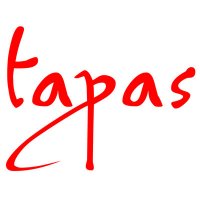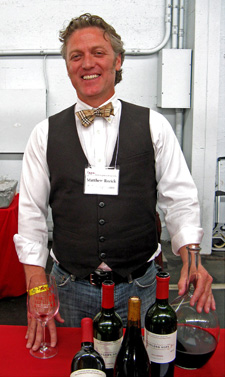Abacela Vineyards and Winery
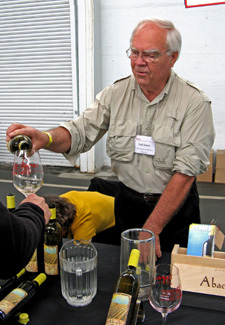 |
Abacela 2010 Albariño, Estate, Umpqua Valley, Southern Oregon. Very light color, with minerally stone fruit, a bit of spice, and a pleasant briny note. Lighter-bodied with a vibrant mouthfeel and crisp finish, very nice.
Abacela 2008 Tempranillo, Southern Oregon. Medium color, fruit-forward raspberry and plum aromas plus a touch of earth. Medium-light weight on the palate, smooth and not very tannic.
Abacela 2007 Tempranillo, Estate, Umpqua Valley, Southern Oregon. Mostly from 1, 2, and 11 clones, aged in 95% French oak, about 10% new. A touch darker color than the ’08 Tempranillo, this was less overtly fruity, showing more earth and spice character along with plum and a touch of pepper. Bigger mouthfeel and grippier tannins than the ’08.
Abacela 2007 Tempranillo, Reserve, Umpqua Valley, Southern Oregon. From 100% Estate fruit, 95% French oak, about 30% new. Medium-dark color, showing a darker fruit profile, tobacco/dried herbs, smoke, and a distinct stony, mineral component. Medium-bodied and fairly smooth, with more refined tannins than the regular Estate bottling, nice.
Comments: Abacela owner (and TAPAS founder) Earl Jones and his wife Hilda were behind the table, and I thought this was the best showing yet for the Abacela wines.
Berryessa Gap Vineyards
Berryessa Gap 2008 Tempranillo, Yolo County. Medium color, fruit-forward aromas featuring ripe strawberry and raspberry, along with touches of spice and smoke. Light-medium bodied, this had moderate tannins and a long finish that highlighted the sweet fruit.
Berryessa Gap 2008 Tempranillo “Rocky Ridge Collection,” Yolo County. Medium-dark color, this showed more earth, herbs, and spicy oak than the regular bottling. Bigger mouthfeel, with fairly chewy tannins that sneaked up on the finish.
Bodega de Edgar
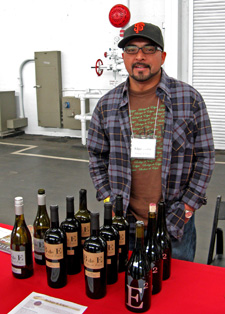 |
Bodega de Edgar 2010 Albariño, Paso Robles. Light straw color, with floral and citrus aromas, plus some pineapple/tropical fruit notes. Moderate acidity, this had a smooth mouthfeel and a tasty finish.
Bodega de Edgar 2009 Garnacha, Central Coast. Sourced 50% each from Cedar Lane and Ishka vineyards. Medium-light ruby color, displaying red fruits, lots of spice, and a touch of sweet oak on the nose. Lively on the palate with moderate tannins and a tasty finish, nice.
Bodega de Edgar 2009 Tempranillo, Paso Robles. Sourced from 90% French Camp and 10% Bella Collina vineyards. Medium purple color, with ripe plum, earth, and herb aromas, with an undercurrent of oak. Medium-bodied with a fairly smooth mouthfeel but bigger tannins on the finish.
Bodega de Edgar 2008 “E2” Arroyo Seco. 45% Grenache, 55% Syrah, from Cedar Lane Vineyard. Darker color, this showed plum and blueberry fruit along with dried herb and pepper notes. Bigger but livelier on the palate than the Tempranillo, with a grippy tannic finish.
Comments: Edgar Torres, who’s worked with McPrice Myers, Russell From, and Augie Hug among others, makes his Bodega de Edgar wines at the Barrel 27 facility in Paso Robles.
Bokisch Vineyards
Bokisch 2010 Albariño, Terra Alta Vineyard, Clements Hills-Lodi. Very light color, with apricot and tropical fruit aromas, medium-bodied on the palate, and a smooth finish.
Bokisch 2010 Garnacha Blanca, Vista Luna Vineyard, Borden Ranch-Lodi. Very light color, showing bright stone fruit, pear, and spice. Showing a minerally side as well as a creamy texture, this had a long, crisp, and delicious finish, quite nice.
Bokisch 2008 Garnacha, Terra Alta Vineyard, Clements Hills-Lodi. 75% Garnacha, 25% Graciano. Medium-light ruby color, the nose featured upfront raspberry, plum, and spice. Medium weight in the mouth, it finished with fairly mild tannins. Good, though I found it not quite as focused as earlier vintages.
Bokisch 2008 Monastrell, Belle Colline Vineyard, Clements Hills-Lodi. 75% Monastrell, 20% Tempranillo, 5% Graciano. Medium-light color, with earthy and slightly peppery plum and darker fruit aromas, plus a touch of dried herbs. Medium-bodied and fairly lively, this had moderate tannins.
Bokisch 2008 Tempranillo, Lodi. 75% Tempranillo, 25% Graciano. Medium color, with earth, leather, and tobacco at the center, framed by plum and blueberry fruit. A nice middleweight Tempranillo, with grippy but not harsh tannins.
Bokisch 2008 Graciano, Las Cerezas Vineyard, Mokelumne River-Lodi. 95% Graciano, 5% Garnacha. Medium-dark purple color, with ripe darker berry fruits, clove and other spices, and a bit of earth/funk. A bit richer mouthfeel, with bigger tannins on the finish.
Comments: Bokisch always presents one of the stronger line-ups of wines at this event. Their Garnacha Blanca may have been my favorite white wine of the tasting, and the Monastrell and Graciano were quite good.
Bonny Doon Vineyard
Bonny Doon 2009 Albariño, Ca’ del Solo Estate, Monterey County. 91% Albariño, 9% Loureiro. Very light color, with minerally stone fruit and spice on the nose. Medium-bodied with a smooth finish.
Bonny Doon 2009 “Vinho Grinho,” Ca’ del Solo Estate, Monterey County. 56% Loureiro, 44% Albariño. Light color, slightly saline character with bright citrus, stone fruit, and herb aromas. Medium-bodied with a lively mouthfeel and crisp finish, very nice.
Comments: Two very good wines, both sourced from Bonny Doon’s biodynamic Ca’ del Solo vineyard near Soledad.
Callaghan Vineyards
Callaghan 2009 “Wayne’s” Grenache, Sonoita, Arizona. Medium-light ruby color, showing very ripe red fruits and lots of spice. Fruit-forward, with medium weight in the mouth with moderate tannins.
Cimarron Vineyards
Cimarron 2009 “Rojo del Sol” Cochise County, Arizona. 68% Tempranillo, 19% Garnacha, 13% Monastrell.Medium-light color, with ripe red fruits and touches of earth and spice. Lighter-bodied and not very tannic.
Comments: Poured at the Dos Cabezas table, this is a collaboration between Dos Cabezas winemaker Todd Bostock and noted Oregon vintner Dick Erath, who owns Cimarron Vineyard.
Core Wine Company
C³ 2007 Reserve Tempranillo, Santa Barbara Highlands Vineyard, Santa Barbara County. Medium color, with ripe plum and blueberry fruit, earth, and oak undertones. Medium-bodied with good structure and moderately grippy finish.
C³ 2006 “Crazy Eights,” Santa Barbara County. 78% Tempranillo, 11% Merlot, 11% Cabernet Sauvignon. Medium-dark purple, showing smoky plum, spice, and herb notes on the nose. A bit smoother on the palate than the Tempranillo, with medium-big tannins.
Core 2006 “Ground Around,” California. 39% Grenache, 36% Tempranillo, 25% Syrah. Medium-dark color, this displayed red fruits, smoke, earth, and pepper aromas. Structured for aging, this had big but fairly refined tannins on the finish. Tasty now, and should develop well with some cellar time.
Core 2007 “Elevation Sensation,” Alta Mesa Vineyard, Santa Barbara County. 62% Grenache, 38% Mourvèdre, 42 months in barrel. Medium-dark color, ripe and high-toned red fruit aromatics, medium-full bodied with grippy tannins.
Core 2007 “Mister Moreved,” California. 93% Mourvèdre, 7% Grenache, 42 months in barrel. Medium-dark purple, this showed earthy dark berry fruit, spice, and pepper on the nose. Big and mouthfilling, this finished with big, chewy tannins that will need some bottle age to mellow out.
Comments: Dave Corey poured wines from both his Core and C³ labels. These wines often improve with some age, and the ’06 “Ground Around” in particular was showing nicely.
Dancing Coyote Wines
Dancing Coyote 2009 Albariño, Clarksburg. Light straw color, bright stone fruit aromas, creamy mouthfeel and smooth, refreshing finish. Straightforward but quite pleasant.
Dancing Coyote 2010 Verdehlo, Clarksburg. Very light color, displaying tropical fruit with touches of herbs and minerals. Medium-bodied, lively and crisp, with a tasty, lingering finish, nice.
Comments: Both wines are made entirely in stainless steel with no malolactic fermentation. This is the second straight year that I’ve been impressed with Dancing Coyote’s wines.
Dos Cabezas WineWorks
Dos Cabezas 2009 “Águileón,” Cimarron Vineyard, Cochise County, Arizona. 95% Tempranillo, 3% Petit Verdot, 1% Souzão, 1% Tinta Cão. Medium purple color, with smoky, earthy darker fruits and a touch of oak. Medium-bodied with a moderately grippy finish.
Dos Cabezas 2009 “El Campo,” Pronghorn Vineyard, Sonoita, Arizona. Blend composed mainly of Tempranillo and Mourvèdre, along with some Petit Verdot, Aglianico, and Roussanne. Medium color, showing both red and black fruits, spice, tobacco, and a savory note. Lively and structured on the palate, with bigger tannins on the finish.
Comments: The ’09 “El Campo” is probably the best wine from Arizona I’ve tasted yet.
Duarte Georgetown Vineyard and Winery
Duarte Georgetown 2009 “Rouge,” El Dorado County. A Rosé made mostly from Grenache, with some Tempranillo. Medium-light pink color, this showed straightforward strawberry aromas with a touch of earth. A somewhat bigger-style Rosé, this finished with some mild tannins.
Duarte Georgetown 2007 Tempranillo, El Dorado County. Blended with 1% Petit Verdot. Medium color, with minerally and bright black cherry, plum, and herb aromas, along with a touch of pepper. Big and structured, with a very grippy tannic finish. A promising wine that needs time to mellow out.
Duarte Georgetown 2008 Tempranillo, El Dorado County. Blended with 1% Petit Verdot. Medium color, this was earthier and less minerally than the ’07, with a bigger herbal component as well. Mouthfilling, with firm, chewy tannins.
Duarte Georgetown 2006 Cabernet Sauvignon, Mountain Vineyard, El Dorado County. Blended with a little Petit Verdot, Malbec, and Syrah. Darker color, with ripe plum, herb, and a touch of smoky oak on the nose. Rich but lively, this wine also had very big tannins on the finish.
Comments: This winery was new to me, and their ’07 Tempranillo was intriguing. They poured an “under the table” Cabernet along with their other wines.
Fenestra Winery
Fenestra 2010 Torrontés, Silvaspoons Vineyard, Lodi. Very light straw color, with subdued floral and perfumed aromatics along with pear and a touch of spice. Medium-light bodied and fairly smooth mouthfeel and finish.
Fenestra 2010 Verdelho, Silvaspoons Vineyard, Lodi. Very light color, mild floral aromas combined with pineapply tropical fruit. A little richer mouthfeel than the Torrontés, with a slightly bitter note on the finish.
Fenestra 2007 Touriga, Silvaspoons Vineyard, Lodi. About 50% each Touriga Nacional and Touriga Franca. Medium-light color, showing plum and boysenberry fruit plus spice and a hint of flowers. Medium-bodied with moderately grippy tannins.
Fenestra 2006 “Tourvanillo,” Silvaspoons Vineyard, Lodi. 53% Touriga, 25% Alvarelhão, 8% Tempranillo, 8% Malbec, 2% Tinto Cão, 2% Cabernet Sauvignon. Medium color, this displayed ripe plum and black cherry, a touch of earth, and some vanilla/oak on the nose. More full-bodied than the Touriga, with bigger tannins on the finish.
Fenestra 2007 Alvarelhão, Silvaspoons Vineyard, Lodi. Medium-light ruby color, aromas of darker berry fruit, spice, and undertones of oak. Bright mouthfeel, finishing with big, chewy tannins.
Fenestra 2008 Tempranillo, Silvaspoons Vineyard, Lodi. Medium purple color, with fruit-forward ripe plum and a touch of earth. Richer mouthfeel, with tannins that are still somewhat harsh and in need of bottle age.
Fenestra 2008 Tempranillo, Livermore. Darker color, showing smoke, earth, and tobacco notes along with blueberry and darker fruits. Mouthfilling yet lively, this had more refined tannins than the Lodi bottling, nice.
Comments: Fenestra always pours a selection of wines made with fruit from Silvaspoons Vineyard, but this year it was their Livermore Tempranillo that was my favorite of the bunch.
|
Forlorn Hope Wines
Forlorn Hope 2010 Torrontés, “La Gitana,” Silvaspoons Vineyard, Alta Mesa. Light color, floral and perfumed aromas along with pear and nectarine fruit. Medium weight in the mouth with good acidity and a long finish, nice.
Forlorn Hope 2009 Verdehlo, “Que Saudade,” DeWitt Vineyard, Amador County. Light color, showing tropical fruit, spice, and a leesy note. Richer and creamier on the palate than the Torrontés, this had a smooth finish.
Forlorn Hope 2010 Alvarelhão, “Suspiro del Moro,” Silvaspoons Vineyard, Alta Mesa (barrel sample). Medium color, quite floral with red fruits and spice on the nose. Medium-bodied, this was clearly a youngster with big and somewhat rough tannins that will take some time to resolve.
Forlorn Hope 2006 “Mil Amores,” DeWitt Vineyard, Amador County. Field blend of Touriga Nacional, Tinta Roriz, Tinta Cão, and Tinta Amarella. Medium color, displaying earthy, leathery plum and darker fruits and spice. Fairly full-bodied and rich, with a grippy finish.
Forlorn Hope 2007 “Mil Amores,” DeWitt Vineyard, Amador County. A pre-release peek at this wine, it has the same field blend as the ’06 bottling. Slightly darker color than the ’06, black cherry and red fruits lead the way, with earth, spice, and a hint of black pepper in support. Livelier in the mouth than the ’06, with a long, tasty finish, very nice.
Comments: Forlorn Hope’s Matthew Rorick was nattily-attired in a bow tie as he poured his wines, which were among the best at the tasting. The wines have no water or acid additions and only older barrels are used for aging.
Hovey Wine
Hovey 2009 Tempranillo, “Rolleri Cuvée,” Calaveras County. Medium-dark color, very bright aromas of plum and darker berry fruit, spice, and sweet oak. Medium-bodied with moderate acidity and tannins.
Irwin Family Vineyards
Irwin 2008 Tempranillo, “Piedra Roja, Block 22,” Sierra Foothills. 90% French oak, 10% American oak, 40% new. Medium-dark purple color, featuring bright black cherry fruit, herbs, and vanilla/oak on the nose. Fairly full bodied, with medium tannins on the finish.
Comments: The vineyard source is in the northern Sierra Foothills near Grass Valley, at about 1,400-foot elevation.
Jeremy Wine Company
Jeremy 2010 Albariño, Lodi. Very light straw color, stony citrus aromas with leesy notes, medium-bodied with a creamy texture in the mouth, and a smooth finish.
Jeremy 2009 Tempranillo, Amador County. Vibrant medium purple color, showing ripe plum, boysenberry, a touch of earth, and lots of spice. Fairly rich mouthfeel, with some grippy tannins on the finish.
Comments: A couple of solid wines from a producer that was new to me.
Longoria Wines
Longoria 2010 Albariño, Clover Creek Vineyard, Santa Ynez Valley. Made entirely in stainless steel. Very light straw color, bright citrus and melon aromas with a touch of fresh herbs on the nose. Medium-light bodied with a crisp finish, nice.
Longoria 2008 Tempranillo, Clover Creek Vineyard, Santa Ynez Valley. 95% Tempranillo, 3% Syrah, 2% Merlot, aged for 19 months entirely in American oak, about 25% new. Medium purple color, showing earth, black cherry, spice, and undertones of sweet oak. Medium-bodied with moderate tannins.
Comments: Although better-known for Pinot Noir, Longoria always comes through with tasty Spanish variety bottlings.
Pierce Ranch Vineyards
Pierce Ranch 2010 Albariño, San Antonio Valley. Very light straw color, showing apricot and citrus aromas with a slight briny note. Lively and fresh on the palate, with a clean finish, nice.
Pierce Ranch 2007 Tempranillo, San Antonio Valley. Medium-dark color, featuring plum and wild berry fruit, along with earth, spice, and smoke components. Medium-bodied with a moderately tannic finish.
Pierce Ranch 2008 “Cosecheiro,” San Antonio Valley. 52% Tempranillo, 38% Touriga, 6% Graciano, 4% Petite Sirah. Medium-dark color, with floral notes supporting earthy black cherry and plum fruit and dried herbs. Medium-bodied with good structure and a tasty finish, nice.
Pierce Ranch 2007 Touriga, San Antonio Valley. About 70% Touriga Nacional and 30% Touriga Franca. Medium-dark color, with floral red fruit aromas, earth, spice, and a touch of oak. More full-bodied, with grippy tannins.
Comments: Nearly all of the fruit for these wines was sourced from the Pierce Ranch estate vineyard in the San Antonio Valley of southern Monterey County. This was a solid group of wines, the best yet from this producer.
Quinta Cruz
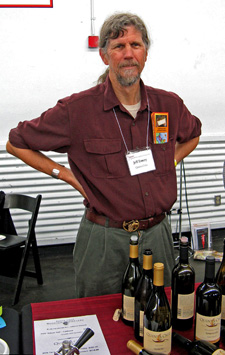 |
Quinta Cruz 2010 Verdelho, Silvaspoons Vineyard, Alta Mesa. Very light color, bright and slightly floral peach aromas with hints of spice. Medium-bodied with lively acidity and refreshing finish, nice.
Quinta Cruz 2008 Tempranillo, Pierce Ranch, San Antonio Valley. Medium ruby color, featuring earthy, leathery wild berry and touches of spice and smoke on the nose. Medium-light bodied with moderate tannins.
Quinta Cruz 2007 “Concertina,” Pierce Ranch, San Antonio Valley. 74% Tinta Roriz, 19% Touriga Nacional, 4% Touriga Franca, 3% Tinta Cão. Medium color, with minerally plum, earth, dried herbs, and a floral note. A bit bigger in the mouth than the Tempranillo but with a very vibrant texture, and a long, tasty finish, very nice.
Quinta Cruz 2008 Touriga, Pierce Ranch, San Antonio Valley. Medium-dark color, the floral character of the Touriga really comes out here, along with darker berry fruit, earth, and spice. More structured on the palate with substantial tannins on the finish. Nice now but should be even better with some bottle age.
Quinta Cruz 2008 Graciano, Bokisch Vineyard, Mokelumne River. Medium-dark color, with dark fruits, baking spices, plus an earthy, funky character that seems common to this variety in California. Fairly rich mouthfeel with grippy tannins.
Quinta Cruz 2006 “Rabelo” Dessert Wine, Late-Bottled Vintage, Pierce Ranch, San Antonio Valley. 50% Tinta Roriz, 25% Touriga Nacional, 25% Tinta Cão. Medium-dark color, with dark chocolate, cherry, caramel, and spice aromas. Medium-light bodied and not overly sweet with a very long finish, quite nice.
Comments: The sister winery of Santa Cruz Mountains Vineyard, Quinta Cruz again featured one of the strongest line-ups at the event. Winemaker Jeff Emery was on hand to pour his wines this year.
Riaza Wines
Riaza 2010 Albariño, Terra Alta Vineyard, Clements Hills-Lodi. Made in stainless steel. Very light color, with slightly floral tropical fruit aromas. Medium-light bodied, with a creamy texture in the mouth and a smooth finish.
Riaza 2010 Garnacha, Terra Alta Vineyard, Clements Hills-Lodi. Aged 7 months in American oak. Light ruby color, showing strawberry, earth, and spicy oak on the nose. Medium-light bodied but with big, grippy tannins.
Riaza 2008 Tempranillo, Amador County. Aged 30 months in American oak. Medium color, ripe black cherry and spice, with caramel and vanilla notes. Richer mouthfeel, with fairly chewy tannins.
Sand-Reckoner Vineyards
Sand-Reckoner 2010 Malvasia Bianca, Cochise County, Arizona. Very light color, quite floral with ripe apricot scents as well. Medium-light bodied with moderate acidity and a fairly smooth and tasty finish.
Comments: Usually associated with Italy, Malvasia has long been grown on the Iberian Peninsula as well. The vineyard is in southeastern Arizona at an elevation of over 4,000 feet.
St. Amant Winery
St. Amant 2010 “Miss Independent” Verdelho, Amador County. Light straw color, with floral and stone fruit aromas, bright acidity on the palate, and a refreshing finish, nice.
St. Amant 2009 “The Old Soldier” Touriga, Amador County. Medium-light purple color, slightly floral plum and darker berry fruit aromas, plus spice and earth notes. Medium-bodied with a lively mouthfeel and moderate tannins.
St. Amant 2008 “The Road Less Traveled” Tempranillo, Amador County. Medium color, showing earthy, smoky plum and black cherry on the nose. More full-bodied than the Touriga, with fairly big tannins on the finish.
St. Amant 2008 “Bootleg” Port, Amador County. From Touriga Nacional, Touriga Franca, Tinta Roriz, Tinta Cão, Souzão, and Bastardo. Dark color, with aromas of dark chocolate and dark berry fruit. Rich mouthfeel with firm tannins, this was a fairly straightforward Port-style wine but quite tasty.
St. Amant NV Tawny Port, Amador County. 100% Bastardo. Medium-light brickish color, this showed caramel, pecan, smoke, and spice aromas. Sweeter and less tannic than the “Bootleg” bottling, with a very smooth texture and long finish, very nice.
St. Amant 2006 Vintage Port, Amador County. From Touriga Nacional, Touriga Franca, Tinta Roriz, Tinta Cão, Souzão, and Bastardo. Dark color, with plum and darker fruits, dark chocolate, and spice – similar in character to the “Bootleg” but with greater depth and focus. Less sweet than the Tawny, with good structure for bottle age, nice.
Comments: Another good showing from St. Amant. In particular, their Port-style bottlings made from traditional Portuguese grape varieties are among the best of that type in California.
Tangent Winery / Trenza Wines
Tangent 2009 Albariño, Paragon Vineyard, Edna Valley. Light color, with mildly floral apple, citrus, and spice aromas. Lively mouthfeel with a clean, crisp finish.
Trenza 2009 “Blanco,” Edna Valley. 50% Albariño (fermented in stainless, aged in neutral French oak), 50% Grenache Blanc (barrel-fermented in 10% new French oak). Very light color, featuring pear, spice, and a touch of oak in the background. Richer mouthfeel than the Albariño with a slight bitter note on the finish.
Trenza 2008 “Tinto,” San Luis Obispo County. 35% Syrah, 31% Grenache, 22% Tempranillo, 12% Mourvèdre, aged in 45% new French oak and 15% new American oak. Medium color, fruit-forward aromas of blueberry and blackberry, smoke, spice, and vanilla/oak. Medium-bodied with moderate tannins.
Truchard Vineyards
Truchard 2007 Tempranillo, Carneros, Napa Valley. Medium-dark purple color, showing bright and minerally plum, earth, and tobacco aromas. Fairly big mouthfeel with grippy tannins on the finish.
Truchard 2002 Tempranillo, Carneros, Napa Valley. Medium color with slight bricking on the edges, this was earthier than the ’07, with darker berry fruits, leather, smoke, and tobacco notes. Smooth but lively on the palate, the tannins were much mellower than the ’07. This is developing quite nicely.
Comments: As they usually do, Truchard generously poured one of their older Tempranillos at this event. It’s a great way to experience how well their wines can develop with bottle age.
Turkovich Family Wines
Turkovich 2009 Grenache, California. 79% Grenache, 14% Syrah, 7% Graciano. Medium-light ruby color, ripe red fruits and lots of spice. Fairly lively mouthfeel with moderate tannins.
Turkovich 2009 “Cosecha III,” California. 43% Grenache, 37% Graciano, 20% Tempranillo. Medium color, displaying aromas of black cherry and plum, earth, smoke, with some floral undertones. Medium-bodied with very good acidity, and fairly grippy tannins that will need some bottle age to smooth out. Nice blend that integrated all the components very well.
Turkovich 2009 Tempranillo, Yolo County. Medium-dark color, with earthy, leathery wild berry fruit and herbs on the nose. More full-bodied on the palate with a very tannic finish.
Comments: Another new winery to me, Turkovich sourced the fruit for the Grenache and “Cosecha III” from Yolo County and from Bokisch Vineyards in Lodi.
Urbanite Cellars
Urbanite 2010 “Caliberico White,” Lodi. 47% Verdelho, 35% Albariño, 18% Torrontés, sourced from Silvaspoons and Bokisch vineyards and made mostly in stainless steel with a little neutral oak. Very light straw color, with bright pear and stone fruit aromas and floral overtones. Medium-light bodied and lively in the mouth, this had a fresh, crisp finish, nice.
Urbanite 2008 “Caliberico Red,” Lodi. 57% Zinfandel, 38% Tempranillo, 5% Tannat, sourced from Silvaspoons and Locust Tree vineyards, aged for 22 months in French and American oak. Medium color, showing black cherry and spice aromas. Relatively smooth mouthfeel with moderate tannins, a fairly basic and fruit-forward red blend.
Comments: Essentially a négociant label, Urbanite works closely with vintners on the wines. Urbanite’s Luis Moya said that the 2011 “Caliberico White” will be made at least partly in a concrete “egg” tank.
|


